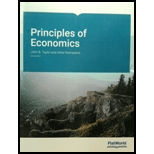
Principles Of Economics V8.0
18th Edition
ISBN: 9781453384503
Author: Taylor, John B.; Weerapana, Akila
Publisher: BOSTON ACADEMIC (DBA FLAT WORLD)
expand_more
expand_more
format_list_bulleted
Concept explainers
Textbook Question
Chapter 16, Problem 12RQ
What is the problem of moral hazard?
Expert Solution & Answer
Want to see the full answer?
Check out a sample textbook solution
Students have asked these similar questions
Published in 1980, the book Free to Choose discusses how economists Milton Friedman and Rose Friedman proposed a one-sided view of the benefits of a voucher system. However, there are other economists who disagree about the potential effects of a voucher system.
The following diagram illustrates the demand and
marginal revenue curves facing a monopoly in an industry
with no economies or diseconomies of scale. In the short
and long run, MC = ATC.
a. Calculate the values of profit, consumer surplus, and
deadweight loss, and illustrate these on the graph.
b. Repeat the calculations in part a, but now assume
the monopoly is able to practice perfect price
discrimination.
The projects under the 'Build, Build, Build' program: how these projects improve connectivity and ease of doing business in the Philippines?
Chapter 16 Solutions
Principles Of Economics V8.0
Ch. 16 - For each of the following purchases, say whether...Ch. 16 - Why is there asymmetric information in the labor...Ch. 16 - Why is it difficult to measure health outcomes?Ch. 16 - Why might it be difficult for a buyer and seller...Ch. 16 - What do economists (and used-car dealers) mean by...Ch. 16 - What are some ways a seller of goods might...Ch. 16 - What are some ways a seller of labor (that is,...Ch. 16 - What are some ways that someone looking for a loan...Ch. 16 - What is an insurance premium?Ch. 16 - In an insurance system, would you expect each...
Ch. 16 - What is an actuarially fair insurance policy?Ch. 16 - What is the problem of moral hazard?Ch. 16 - How can moral hazard lead to more costly insurance...Ch. 16 - Define deductibles, copayments, and coinsurance.Ch. 16 - How can deductibles, copayments, and coinsurance...Ch. 16 - What is the key difference between a...Ch. 16 - How might adverse selection make it difficult for...Ch. 16 - What are some of the metrics economists use to...Ch. 16 - You are on the board of directors of a private...Ch. 16 - A website offers a place for people to buy and...Ch. 16 - How do you think the problem of moral hazard might...Ch. 16 - To what sorts of customers would an insurance...Ch. 16 - Using Exercise 16.20, sketch the effects in parts...
Additional Business Textbook Solutions
Find more solutions based on key concepts
An experimental composite engine block for an automobile will trim 20 pounds of weight compared with a traditio...
Engineering Economy (17th Edition)
Indefinite-Life Intangible Asset Impairment. Genius Auto Malls recently conducted its annual impairment review ...
Intermediate Accounting (2nd Edition)
Quick ratio (Learning Objective 7) 510 min. Calculate the quick assets and the quick ratio for each of the foll...
Financial Accounting, Student Value Edition (5th Edition)
E6-14 Using accounting vocabulary
Learning Objective 1, 2
Match the accounting terms with the corresponding d...
Horngren's Accounting (12th Edition)
Define investors’ expected rate of return.
Foundations Of Finance
Knowledge Booster
Learn more about
Need a deep-dive on the concept behind this application? Look no further. Learn more about this topic, economics and related others by exploring similar questions and additional content below.Similar questions
- Critically analyse the five (5) characteristics of Ubuntu and provide examples of how they apply to the National Health Insurance (NHI) in South Africa.arrow_forwardCritically analyse the five (5) characteristics of Ubuntu and provide examples of how they apply to the National Health Insurance (NHI) in South Africa.arrow_forwardOutline the nine (9) consumer rights as specified in the Consumer Rights Act in South Africa.arrow_forward
- In what ways could you show the attractiveness of Philippines in the form of videos/campaigns to foreign investors? Cite 10 examples.arrow_forwardExplain the following terms and provide an example for each term: • Corruption • Fraud • Briberyarrow_forwardIn what ways could you show the attractiveness of a country in the form of videos/campaigns?arrow_forward
arrow_back_ios
SEE MORE QUESTIONS
arrow_forward_ios
Recommended textbooks for you
 Principles of MicroeconomicsEconomicsISBN:9781305156050Author:N. Gregory MankiwPublisher:Cengage Learning
Principles of MicroeconomicsEconomicsISBN:9781305156050Author:N. Gregory MankiwPublisher:Cengage Learning Economics (MindTap Course List)EconomicsISBN:9781337617383Author:Roger A. ArnoldPublisher:Cengage Learning
Economics (MindTap Course List)EconomicsISBN:9781337617383Author:Roger A. ArnoldPublisher:Cengage Learning
 Exploring EconomicsEconomicsISBN:9781544336329Author:Robert L. SextonPublisher:SAGE Publications, Inc
Exploring EconomicsEconomicsISBN:9781544336329Author:Robert L. SextonPublisher:SAGE Publications, Inc Principles of Economics 2eEconomicsISBN:9781947172364Author:Steven A. Greenlaw; David ShapiroPublisher:OpenStax
Principles of Economics 2eEconomicsISBN:9781947172364Author:Steven A. Greenlaw; David ShapiroPublisher:OpenStax

Principles of Microeconomics
Economics
ISBN:9781305156050
Author:N. Gregory Mankiw
Publisher:Cengage Learning

Economics (MindTap Course List)
Economics
ISBN:9781337617383
Author:Roger A. Arnold
Publisher:Cengage Learning


Exploring Economics
Economics
ISBN:9781544336329
Author:Robert L. Sexton
Publisher:SAGE Publications, Inc

Principles of Economics 2e
Economics
ISBN:9781947172364
Author:Steven A. Greenlaw; David Shapiro
Publisher:OpenStax
